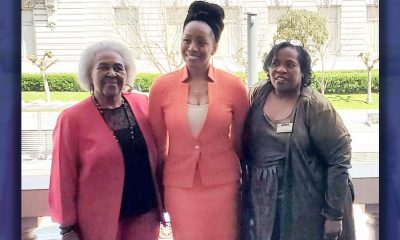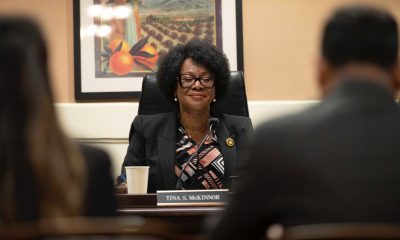Bay Area
California Reconsiders Potential of College Work-Study Jobs
When she returned to school to become a nurse, Karina Mendez wanted a work-study job that she could balance with classes at City College of San Francisco. Thanks to a new program in California, she landed one that does more than pay the bills — it gives her a career boost. Mendez works to support patients with cancer at UCSF, helping her get a foot in the door of a hospital where she’d love to be a nurse

By Emma Gallegos
EdSource
When she returned to school to become a nurse, Karina Mendez wanted a work-study job that she could balance with classes at City College of San Francisco. Thanks to a new program in California, she landed one that does more than pay the bills — it gives her a career boost.
Mendez works to support patients with cancer at UCSF, helping her get a foot in the door of a hospital where she’d love to be a nurse.
“It gives me a sense of hope that I could be a part of the UCSF department,” Mendez said.
She is one of the first beneficiaries of a new state-funded work-study program called the Learning-Aligned Employment Program. It pays the wages of students who are considered underrepresented in a job that aims to give them a leg up in their careers — unlike traditional work-study positions in campus cafeterias or bookstores that have little connection to students’ future career goals.
Besides medicine, the fields include tech, engineering, clean energy, education and university research.
The state invested $500 million of its budget surplus into the program, which is run by the California Student Aid Commission. Over 98% of public colleges and universities have signed on to participate.
The program is in its early days. Funds were rolled out to the state’s public colleges and universities this fall, and institutions have until 2031 to use them. Some colleges and universities have small pilot programs, but most are in the planning stages of using this funding.
It’s too soon to say how many students are participating statewide. In the long run, state funding could provide opportunities for about 100,000 students like Mendez — who makes $20 an hour — working 15 hours weekly for a semester.
Ohlone College in the East Bay has a small pilot, and it is hearing from other colleges in the Bay Area Community College Consortium looking for ideas of how best to spend the funding.
“It has taken a fair amount of time to figure out how we will use these LAEP funds, because it’s in its infancy,” said Kelsey Bensky, program manager for the college’s Career Services.
Eloy Ortiz Oakley, president and CEO of the College Futures Foundation, applauded California for using work-study funds this way. He called it “an important piece of a larger puzzle.”
“Students are hungry for this experience,” said Oakley, former chancellor of California Community Colleges. “They want to see that their work in the classroom is connected to their employment.”
Mendez said her role in the UCSF Patient Support Corps is giving her a preview of what a nurse’s duties look like. She reviews patients’ charts and checks in with them during telehealth appointments.
“I see words that I’m studying at school,” she said. “I’m learning how to communicate with cancer patients at a sensitive time in their life.”
Fixing The Disconnect Between School and Work
Most students work their way through college, but often these jobs have nothing to do with their career aspirations. The state and federal governments are working to change that.
Adele Burnes, deputy chief of Californa’s Division of Apprenticeship Standards, put it this way: “What if that work was really, intentionally connected to their education?”
Critics say that the lack of opportunities for college students to learn on the job is a symptom of the larger disconnect between the California economy and higher education. The state is making important strides on this front, Oakley said, but it is still behind many European countries, Singapore and even states like Indiana and Texas.
“Employers have not invested time and effort to make this work,” said Oakley. “Colleges don’t always have the resources to make this work.”
A lot of work goes into creating a high-quality internship, such as figuring out which students are eligible and vetting opportunities from employers, said Gina Del Carlo, the founding director of Earn & Learn. The Bay Area Community College Consortium contracted with Earn & Learn to guide 25 Bay Area colleges pursuing this work-study funding.
“It’s not as simple as: ‘Here’s an opportunity, here’s a student,’” said Alejandro Sandoval, director of product delivery and expansion for Earn & Learn.
Ohlone College has partnered with 11 organizations, including a local biotech company, an engineering company, a consulting firm and several community nonprofits. Del Carlo has noticed that many colleges are using the funds to pay students to conduct research relevant to their major.
Many fields, such as health care, technology, education and government, face shortages of educated workers.
But work-based learning opportunities that help students get a foothold in a new career have often been limited to building-trade apprenticeships like electrician or welder. Critics say white-collar professional internships — often unpaid — tend to go to well-connected students who can afford to forgo salaries.
This hurts both employers seeking workers and workers who fear college will leave them with debt rather than better career prospects, according to the Governor’s Council for Post-Secondary Education.
Despite placing a greater emphasis on vocational education, this has even been a problem at community colleges, said Sonya Christian, who was recently named chancellor of California Community Colleges.
She said the academic transfer mission should be better integrated with the vocational mission, and every student should expect a chance to learn on the job. She said “earn and learn” opportunities unite these two missions while opening higher education to students who thought they couldn’t afford it.
The Next Big Wave
The Learning-Aligned Employment Program launched in the 2021-21 budget after a report from the Governor’s Council for Post-Secondary Education warned: “Connections between higher education and the workforce are insufficient to meet the economic and workforce needs of California.”
The funds are intended for students who are considered underrepresented. That includes students are low-income, parents, displaced workers, formerly incarcerated, undocumented or have disabilities.
Those who are first generation in their families to attend college, current or former foster youth, homeless or at risk of becoming homeless are also eligible and given priority for the opportunities through state guidelines. Majors in science, technology, engineering or math (STEM) also have priority.
“This new approach to hiring low-income, first-generation college students to work in vital, growth industries provides students with valuable career opportunities, while also helping make those fields become more inclusive and diverse in the process,” said Marlene Garcia, executive director of the California Student Aid Commission.
This money from the state supports the UCSF Patient Support Corps’ efforts to recruit community college students whose diversity, language and culture mirror the patient population, said Jeff Belkora, director of the program.
“The whole idea of me being a Latina in this program, it makes me feel like I belong,” said Mendez. “It gives me hope that I could do this.”
The state opted to give colleges the money in a lump sum to give campuses the time and money to plan the program.
State funds will pay for up to half of student wages at for-profit employers, 90% at a public educational institution or a nonprofit and 100% of the wages at the UC, CSU or community colleges.
Only 5% of the funds can be spent on administration and the rest must be spent directly on students’ wages. Students should be paid a rate comparable to regular employees doing similar work in the company or in the same field. The state recommends that students be given academic credit as well.
Funds are distributed based on the share of students receiving a federal Pell Grant. That makes community colleges one of the biggest beneficiaries. They will receive 56% of funds, while 31.8% will go to the CSU system and the remaining 12.2% will go to the UCs.
Oakley believes the state is on the right track, but he hopes that these partnerships are not just short-lived, successful “boutique programs.” Programs should reach poor, underserved students and communities in the state, he said, and the state and federal governments don’t have a successful track record of making these programs accessible.
“The more streamlined we can make it, the less friction, the more we can make sure that it’s helping the people who need it the most,” he said.
One of the early programs is the Junior Leadership Academy at Ohlone College. Cohorts of 20 students receive coaching in a 15-week career readiness class for credit, while working on a project for a local employer that involves research connected to their field.
This includes business students working for a consulting firm and engineering students at an engineering firm.
Some employers and students have enjoyed the opportunity enough to seek to extend projects beyond their 75 hours-a-semester commitment.
While it has taken time to sort through funding restrictions, such as figuring out exactly which students are eligible, Bensky, the program manager at Ohlone, appreciates the flexibility the state has offered.
“It’s been quite a bit of work, but I’m happy,” said Bensky.
Activism
Oakland Post: Week of April 24 – 30, 2024
The printed Weekly Edition of the Oakland Post: Week of April 24 – 30, 2024

To enlarge your view of this issue, use the slider, magnifying glass icon or full page icon in the lower right corner of the browser window. ![]()
Alameda County
DA Pamela Price Stands by Mom Who Lost Son to Gun Violence in Oakland
Last week, The Post published a photo showing Alameda County District Attorney Pamela Price with Carol Jones, whose son, Patrick DeMarco Scott, was gunned down by an unknown assailant in 2018.
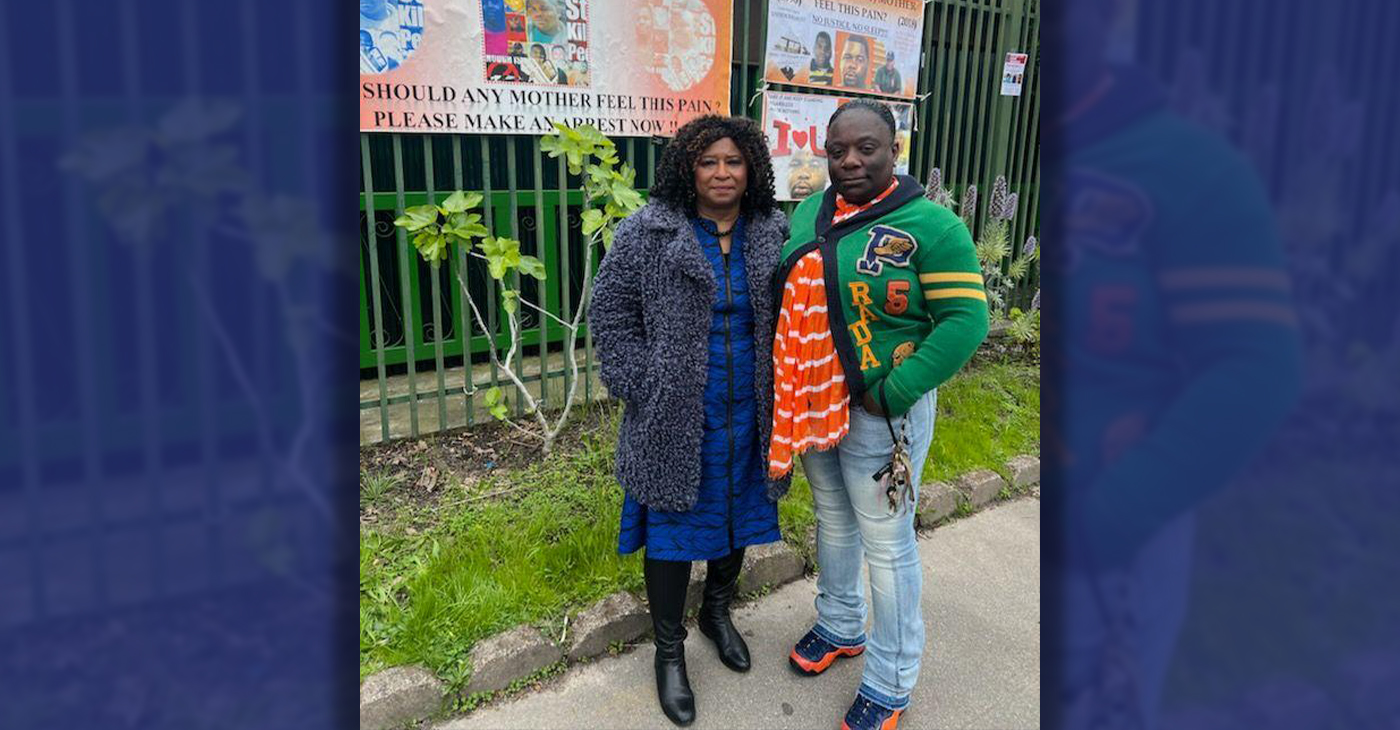
Publisher’s note: Last week, The Post published a photo showing Alameda County District Attorney Pamela Price with Carol Jones, whose son, Patrick DeMarco Scott, was gunned down by an unknown assailant in 2018. The photo was too small for readers to see where the women were and what they were doing. Here we show Price and Jones as they complete a walk in memory of Scott. For more information and to contribute, please contact Carol Jones at 510-978-5517 at morefoundation.help@gmail.com. Courtesy photo.
Bay Area
State Controller Malia Cohen Keynote Speaker at S.F. Wealth Conference
California State Controller Malia Cohen delivered the keynote speech to over 50 business women at the Black Wealth Brunch held on March 28 at the War Memorial and Performing Arts Center at 301 Van Ness Ave. in San Francisco. The Enterprising Women Networking SF Chapter of the American Business Women’s Association (ABWA) hosted the Green Room event to launch its platform designed to close the racial wealth gap in Black and Brown communities.
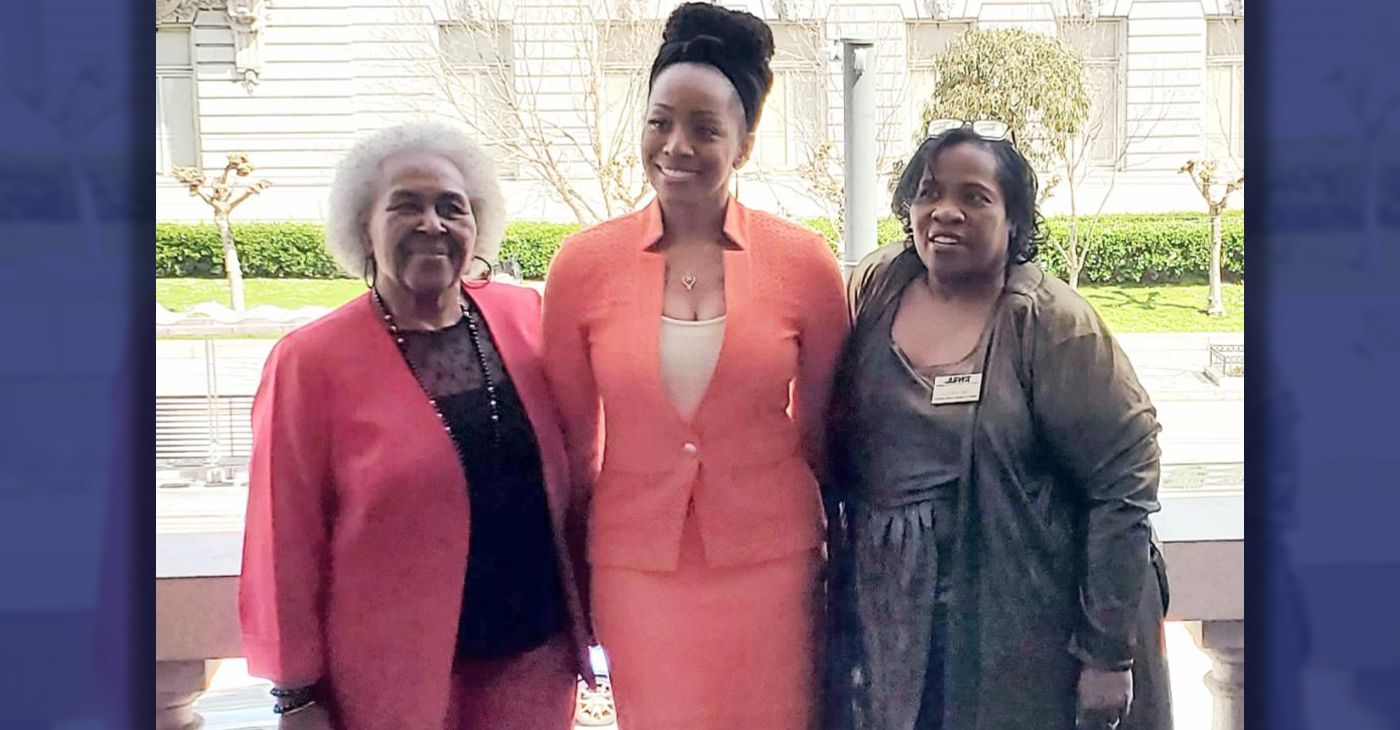
By Carla Thomas
California State Controller Malia Cohen delivered the keynote speech to over 50 business women at the Black Wealth Brunch held on March 28 at the War Memorial and Performing Arts Center at 301 Van Ness Ave. in San Francisco.
The Enterprising Women Networking SF Chapter of the American Business Women’s Association (ABWA) hosted the Green Room event to launch its platform designed to close the racial wealth gap in Black and Brown communities.
“Our goal is to educate Black and Brown families in the masses about financial wellness, wealth building, and how to protect and preserve wealth,” said ABWA San Francisco Chapter President LaRonda Smith.
ABWA’s mission is to bring together businesswomen of diverse occupations and provide opportunities for them to help themselves and others grow personally and professionally through leadership, education, networking support, and national recognition.
“This day is about recognizing influential women, hearing from an accomplished woman as our keynote speaker and allowing women to come together as powerful people,” said ABWA SF Chapter Vice President Velma Landers.
More than 60 attendees dined on the culinary delights of Chef Sharon Lee of The Spot catering, which included a full soul food brunch of skewered shrimp, chicken, blackened salmon, and mac and cheese.
Cohen discussed the many economic disparities women and people of color face. From pay equity to financial literacy, Cohen shared not only statistics, but was excited about a new solution in motion which entailed partnering with Californians for Financial Education.
“I want everyone to reach their full potential,” she said. “Just a few weeks ago in Sacramento, I partnered with an organization, Californians for Financial Education.
“We gathered 990 signatures and submitted it to the [California] Secretary of State to get an initiative on the ballot that guarantees personal finance courses for every public school kid in the state of California.
“Every California student deserves an equal opportunity to learn about filing taxes, interest rates, budgets, and understanding the impact of credit scores. The way we begin to do that is to teach it,” Cohen said.
By equipping students with information, Cohen hopes to close the financial wealth gap, and give everyone an opportunity to reach their full financial potential. “They have to first be equipped with the information and education is the key. Then all we need are opportunities to step into spaces and places of power.”
Cohen went on to share that in her own upbringing, she was not guided on financial principles that could jump start her finances. “Communities of color don’t have the same information and I don’t know about you, but I did not grow up listening to my parents discussing their assets, their investments, and diversifying their portfolio. This is the kind of nomenclature and language we are trying to introduce to our future generations so we can pivot from a life of poverty so we can pivot away and never return to poverty.”
Cohen urged audience members to pass the initiative on the November 2024 ballot.
“When we come together as women, uplift women, and support women, we all win. By networking and learning together, we can continue to build generational wealth,” said Landers. “Passing a powerful initiative will ensure the next generation of California students will be empowered to make more informed financial decisions, decisions that will last them a lifetime.”
-

 Community2 weeks ago
Community2 weeks agoFinancial Assistance Bill for Descendants of Enslaved Persons to Help Them Purchase, Own, or Maintain a Home
-

 Activism3 weeks ago
Activism3 weeks agoOakland Post: Week of April 3 – 6, 2024
-

 Business2 weeks ago
Business2 weeks agoV.P. Kamala Harris: Americans With Criminal Records Will Soon Be Eligible for SBA Loans
-

 Community2 weeks ago
Community2 weeks agoAG Bonta Says Oakland School Leaders Should Comply with State Laws to Avoid ‘Disparate Harm’ When Closing or Merging Schools
-

 Activism2 weeks ago
Activism2 weeks agoOakland Post: Week of April 10 – 16, 2024
-

 Community1 week ago
Community1 week agoOakland WNBA Player to be Inducted Into Hall of Fame
-

 City Government2 weeks ago
City Government2 weeks agoLAO Releases Report on Racial and Ethnic Disparities in California Child Welfare System
-
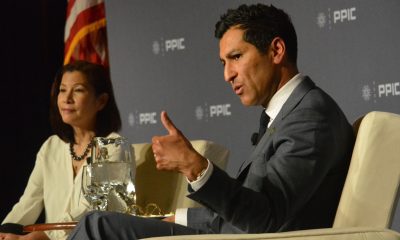
 Community2 weeks ago
Community2 weeks agoThe Year Ahead: Assembly Speaker Rivas Discusses Priorities, Problems

